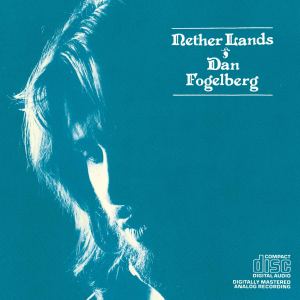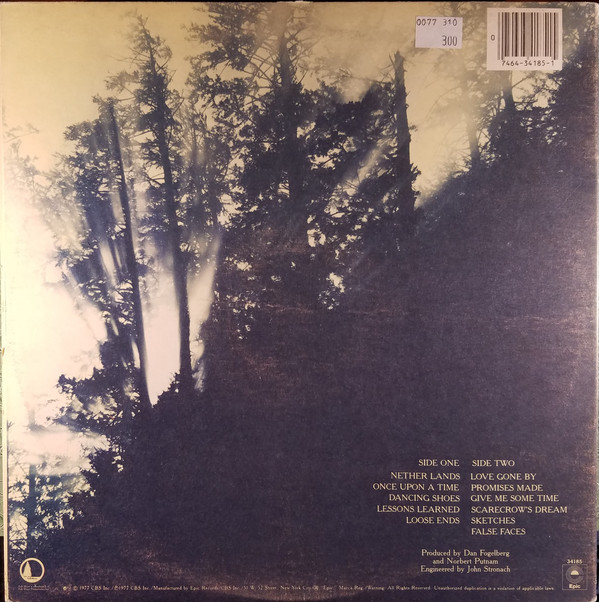“It shows my search for the intricacies of the human psyche, something that is a lot tougher than writing and singing about love. I want bigger themes than love songs.” So said Dan Fogelberg to the Colorado Gazette Telegraph’s George Gladney in June 1978 when reflecting upon Nether Lands, which was released in May 1977.
Or as he explained to Michael Barackman of the Los Angeles Times in August 1977, “This may sound pompous, but I don’t want to be a rock star. I don’t want to be Peter Frampton. I’ve lived on food stamps before and I can live on them again. All I want is respect.” He expanded upon that thought with this: “Rock ’n’ roll is terrific, but it’s confining. I think I have much more to say musically. I think classical composers have said a lot more than anybody in the last 20 years has in pop. One Tchaikovsky concerto says a lot more than Sgt. Pepper as far as I’m concerned. It’s very limiting to write lyrics and melodies and chord changes. And I’m getting real bored with that, to tell you the truth.”
Some may well hear that as pompous, as Fogelberg feared. I don’t. I hear it as him moving past the overt influences that were part and parcel of his sound up until this point of his career and establishing his own style. His first three albums, at least to my ears, mimicked Crosby, Stills & Nash and/or the Eagles, trading in harmonies and similar song constructions, with lyrics that often weren’t up to snuff. The subjects were love in all its many splendors, from unrequited to found to heartbreak.
But by age 25, which is how old he was when writing and recording Nether Lands, he’d been there, done that. The album expands upon his musical palette, adding elements of classical to his country-folk-rock hybrid. It wasn’t his first attempt at doing so, mind you; the lead-off track to his previous LP, 1975’s Captured Angel, opened with the string-heavy “Aspen,” after all, and strings accent several tracks on Souvenirs. The same holds true for expanding his lyrical scope to beyond matters of the heart – he’d done it before, just not as well. Living something vs. imagining it makes a world of difference. Unlike his earlier works, it’s the sound of Fogelberg being Fogelberg.
Which is to say, although I have my quibbles with it, it’s safe to say that Nether Lands – produced by Norbert Putnam – is his best album up to this point of his career. It’s a mature work, home to memorable melodies and strong lyrics. As he himself noted in a 1994 interview with Lydia Hutchinson, “I think that was the first mature record I ever made. To me when I listen to the first three, that’s a kid. I think Nether Lands was the man growing up. And I think it was musically mature, but also the lyrics finally had some real depth and philosophical strength to them that I’d never had before.”
It’s interesting to note that the cover art echoes another singer-songwriter’s LP – Joni Mitchell’s Blue. That said, it’s not a five-star outing or match for Joni’s, though close. Its biggest flaw is the marriage of his classical desires with his singer-songwriter’s heart on the title track, which opens the 11-track set.
A tad syrupy, no? It reminds me to an extent of Neil Young’s collaboration with the London Symphony Orchestra on “A Man Needs a Maid” and “There’s a World” (from Harvest) in that the symphonic flourishes overwhelm the song. Stripped of the production gloss and dross, however, the song is a true stunner – as the rendition found on the archival Live at Carnegie Hall album, which features a solo Fogelberg in 1979, proves.
That said, thematically, the song pushes past his typical love themes to ponder the intricacies of life itself: “Once in a vision I came on some woods/And stood at a fork in the road/My choices were clear yet I froze with the fear/Of not knowing which way to go/Oh, one road was simple acceptance of life/The other road offered sweet peace/When I made my decision/My vision became my release.” As such, it’s actually a great lead-off track – if you can listen past the strings, that is. (Of course, I’m coming at this decades after the fact. If I’d first heard the track way back, as an impressionable teen or young adult, perhaps I’d feel differently.)
The remainder of the album is as strong as “Nether Lands” sans orchestra, though one song, “Dancing Shoes,” features a string quartet and the finale, “False Faces,” features the orchestra en masse. “Dancing Shoes,” which Diane calls “such a pretty song,” is a love-themed number inspired by his girlfriend at the time, a dancer, who went onto become his first wife.
My favorite song from the album, however, is “Loose Ends,” which is similar in some ways to “The River,” “As the Raven Flies” and “Crow” from his previous outings. The main difference: the lyrics, which explore how some things are left unresolved: “And the chords struck at birth grow more distant/Yet, we strike them again and again/And we plead and we pray for a glimmer of day/As the night folds its wings and descends/Exposing the loose ends.”
As on his previous albums, Fogelberg handles the bulk of the instruments himself, though pals Don Henley, John David Souther and Joe Walsh pop up on some tracks while drummers Kenny Buttrey, Russ Kunkel and Joe Vitale take turns keeping the beat. And, tipping off his next release, flautist Tim Weisberg performs on “Give Me Some Time.”
Unlike the Captured Angel album, which faded into the background for me, it’s remained front and center when I’ve played it. I should note that, just as Diane likes “Dancing Shoes,” the album is her favorite of his releases. To my ears, it’s a stellar outing, the best of his first four LPs and well worth many listens.
The track listing:
Past, present & future entries in the series…
- 1/9/21: An Introduction
- 1/10/21: Home Free
- 2/20/21: Souvenirs
- 4/17/21: Captured Angel
- 6/19/21: Nether Lands
- 7/10/21: Twin Sons of Different Mothers
- 7/17/21: Phoenix
- 8/8/21: The Innocent Age
- 9/25/21: Windows and Walls
- 10/10/21: High Country Snows
- 12/29/21: Exiles
- 2/6/22: The Wild Places
- 1/7/23: River of Souls



What is the symbol on the album cover between his name and the title of the album?
LikeLike
“As such, it’s actually a great lead-off track – if you can listen past the strings, that is. (Of course, I’m coming at this decades after the fact. If I’d first heard the track way back, as an impressionable teen or young adult, perhaps I’d feel differently.)”
Perhaps you would 🙂 As someone who heard it shortly after release, I am still haunted by the music and lyrics and vocals some 46 years later. I still get emotional when hearing it.
Excellent article, and thanks for the heads-up on his live performance at Carnegie, missed that one somehow.
LikeLike